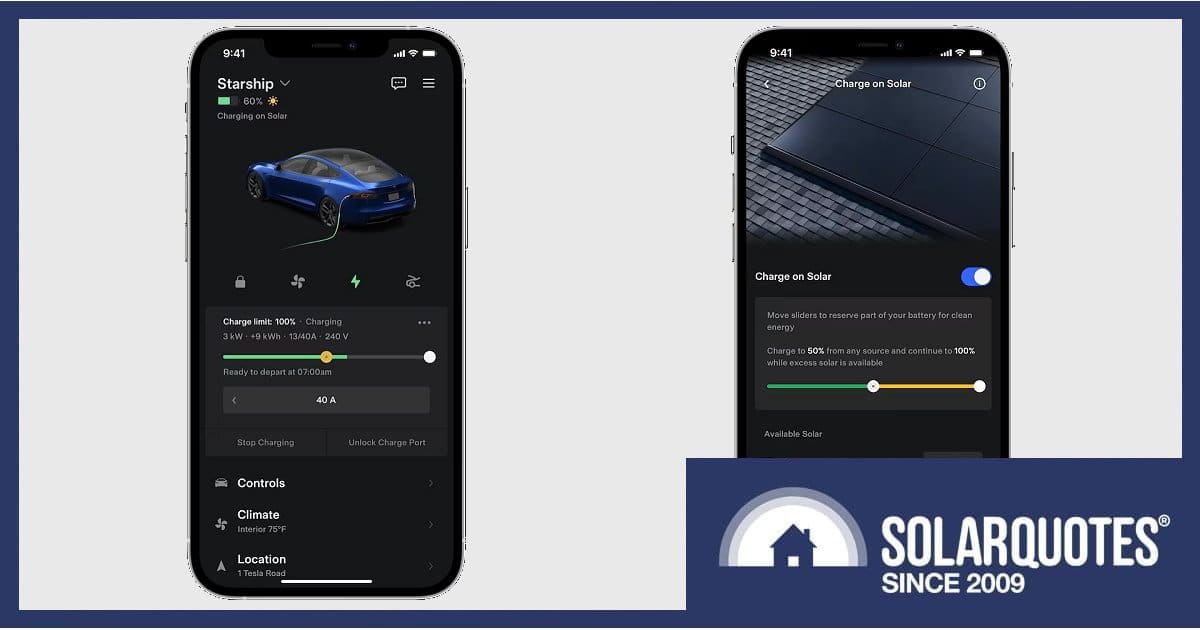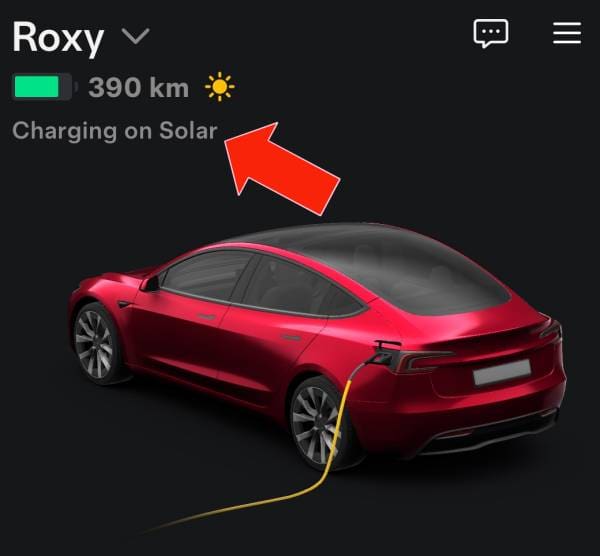
After a trial run, the Tesla app’s Charge on Solar feature is now available to all Australian owners of a Powerwall and compatible Tesla electric vehicles – and it should work with any hard-wired home EV charger.
When initiated, the feature enables owners to charge only when surplus electricity is being produced by their solar power system, without dipping into mains grid supply (or the Powerwall) – but there’s flexibility also built in.
Once set up, Charge on Solar will kick in when there’s at least 1.2 kW of stable surplus solar electricity. The vehicle will adjust charge power approximately every 10 seconds; matching surplus generation and electricity consumption elsewhere in the home. This, according to Tesla, is to maximise efficiency and the service life of EV charging equipment being used.
A trial of the feature was launched early this year in Australia to randomly selected owners, but we’re informed it’s now available to all Australian Tesla owners who have the required vehicle, hardware and software, being:
- Model S, Model 3, Model X or Model Y (but 2012-2020 Model S and 2015-2020 Model X currently don’t support it) – software: 2023.32 or higher
- Powerwall – software: 23.12.10 or higher
- Tesla app – software: 4.30.5 or higher
Tesla indicates Powerwall’s Storm Watch, Backup Reserve, Self-Powered and Time-Based control modes will work seamlessly with Charge on Solar.
The feature also offers a function whereby adjusting one slider in the app allows you to charge to a specified level from solar and the grid, and the other to charge only with excess solar to the limit you select. For example, you could start topping up as usual (solar + grid) for daily driving to 40%, then only with surplus power from PV to 90%.
Scheduled charging enables using excess solar until a specified time, after which the vehicle will accept supply from any source up to the lower charging limit set.
To use Charge on Solar, you’ll need to specify a location to avoid issues when at another location where surplus solar energy isn’t available.
Tesla EV Charger Not Required
Tesla’s hard-wired home EV charger is called the Wall Connector, the Gen 3 version of which costs around $800 before installation. But it seems you won’t need this bit of kit if you already have another device installed at your place. SolarQuotes founder Finn is successfully using the feature with his solar power system, a Powerwall 2, a Delta EV charger and a Tesla Model 3.
For further information on Tesla’s Charge on Solar and how to set it up, details are on this page. And if you’re in the market for an EV charger (Tesla owner or otherwise), compare models available in Australia including those with solar smart charging support on the SolarQuotes EV charger comparison table.
In other recent Tesla news, the company held a media and installer briefing about the new Tesla Powerwall 3 (PW3) in Sydney late last week. SQ’s Neerav Bhatt was at the event and has answers to a bunch of Powerwall 3 questions. Finn has also weighed in PW3; answering the question: “is it the right choice for every Australian household that wants a home battery?”
PW3 (and Powerwall 2) pricing and specifications can be found on SQ’s solar battery comparison table, where you can see how they stack up against other home energy storage solutions available in Australia.


 RSS - Posts
RSS - Posts



My older Fronius Symo 3-phase gives me a 12V signal, which I have sent to a 40A SSR to drive the H/W system based on production and not surplus as set in the device management software, in my case when 2,400W is being produced. I know what it is being running, so I can make the decision. It would need another $500 + installation gadget from Fronius to drive it on surplus.
In the absence of bi-directional chargers in NZ, I want to create a connection from the DC charging port on my Nissan Leaf 2022 62Kwh to a solar inverter.
This solar inverter then connects to the Powerwall 2 system, which already has 2 solar inverters from an solar array feeding into it. To power the house from the EV, use the DC connection. To charge the car on solar, disconnect the DC plug and charge via the AC socket on the car.
This is my theory, will this work in practice or can anyone maky any suggestions?
Case Aarts NZ
The Chinese make CHAdeMO V2L inverters which you can find reference to via Andy’s Off Grid Garage & his adjacent PHEV channel.
Beyond that you’re either going to need professional qualifications & an appetite for risk that I wouldn’t recommend.
Thank you for your reply. I want to go off grid, so V2L won’t work. I intend to engage a professional installer once I have established whether my theory will actually work.
For an off grid application you need a Selectronic SpPro and to make it easy HOEM device would mean you could easily change between V2H and the hardwired backup generator you’ll need in any case.
Great article. I am about to get the new Powerwall 3 installed with solar. Currently have the Tesla Model 3 and just using the normal 240 V portable connector for charging. I have found that I haven’t really needed the faster charge speed of the Wall Connector. My question is – does the “Charge on Solar” feature with the Powerwall work with the portable Tesla charging lead? Thanks.
Hi Brad,
Chargers plugged into a wall socket aren’t really “smart” devices, they would need a WiFi connection for that. (Fronius Wattpilot GO will do it)
You can improve them a little with a timer, or smarten them some more with a circuit controlled by solar yield.
Or just carry on like I have ;
https://www.solarquotes.com.au/blog/ev-charging-power-outlet/
Thanks Anthony for your reply.
Updates – I have now installed the Tesla Powerwall 3. I have the Tesla Model 3 and just the mobile Tesla Charger connected to a 15-amp plug in the garage.
I can now confirm that the Tesla “Charge on Solar” feature does work without the need for other types of connectors. “Charge on Solar” feature is working well with my mobile connector, just plugged into the wall.
Cheers.
Good news Brad,
This is why we recommend people stick with an ecosystem. Even though Tesla rely on using smarts in the vehicle instead of the wall connector, the bottom line is that it’s all stitched together with compatible software.
15a @ 230VAC would mean a maximum 3.45kW available but in reality you’ll get perhaps 3kW going on some I’ve measured.
Do you notice what the minimum charge rate is for the car? Some vehicles won’t accept charging at less than 1.6kW.
Thanks for the feedback
Do you know if there is any prospect of Tesla’s “Charge on Solar” becoming independent of the Powerwall? Seems at the moment that if you don’t have a Powerwall you should not install a Tesla Wall Connector if you want to use excess solar, but I can’t see why a Powerwall should be necessary.
Hi Andrew,
Tesla have enabled OCPPon the wall connector and they seem to making it a smarter device more generally but I’m not sure about stand alone solar charging. The wall connector needs to be able to know what your solar is doing so having a consumption meter in the switchboard will be essential, and the Powerwall fills that role.
more details here
https://www.solarquotes.com.au/blog/tesla-ev-charger-sa/
https://www.solarquotes.com.au/blog/ev-draining-home-battery/
There is now a Tesla app for the Apple Watch. It is mainly for Tesla car owners (eg unlocking door etc) but it also has an undocumented Powerwall feature that displays SoC, solar generation etc. There is a “complication” (i.e. icon on watch face) for displaying the car SOC but no sign of a Powerwall complication.
I was hoping that the iPhone Tesla app would be improved to give me useful notifications such as when grid export exceeded a certain value (time to start charging that EV!) but it has not materialised.